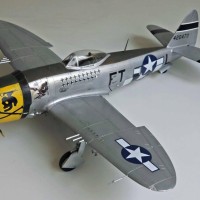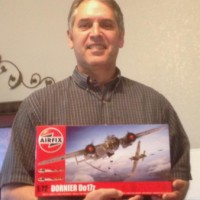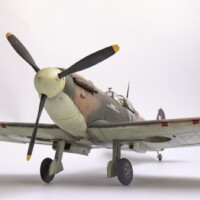A second life- as a mayfly! N1K1-J Shiden, 341 Kokutai, 402 Hikotai, in US Hands
On the evaluation of captured Japanese aircraft: the work of the "Tactical Air Intelligence Units" TAIU, illustrated by the fate of the N1K1-J Shiden "341S-23".
All parties to the conflict in World War II tried to find out as much as possible about the material and potential of the enemy's armament efforts. The best form for these intelligence and technical efforts depended not only on the military circumstances, but also on the climatic and geographical characteristics of the respective theatres. The vast expanses of the Pacific, for example, presented a particular difficulty in obtaining enemy material: downed aircraft usually disappeared into the inaccessible depths of the ocean or hit the ground in nameless and inaccessible jungle areas. The former made recovery and evaluation completely impossible, the latter made recovery - if at all possible - immensely complicated.
Thus, the discovery of intact aircraft material left behind was always a stroke of luck. US troops were soon instructed on how to deal with the flying material, since, in addition to combat-related vandalism, the almost uncontrollable custom of "souvenir hunting" posed a further risk to the subsequent evaluation of the enemy material that should not be underestimated.
The N1K1-J Shiden shown here was an aircraft type that must have been of particular interest to the American side. With the unique history of having been developed as a superior design from the seaplane N1K1 Kyofu (Rex) to the land plane N1K1 Shiden ("George"), the experts from TAIU-SWPA (Tactical Air Intelligence Unit- South West Pacific Area) must have been particularly interested in this aircraft type. The Kawanishi N1K1, heavily powered, fast, manoeuvrable and long-range, and armed with an impressive arsenal of four 20mm machine guns and two 7.62mm machine guns, was more than a match for the best the Allies had to offer in air combat.
Until October 1944, the Shiden shown with the registration 341S-23 belonged to the 341 Kokutai, 402 Hikotai, a unit stationed in the Philippines and flying missions against the advancing Allies from airfields in and near the capital Manila. After conquering the island, it had been found intact with a number of other Japanese aircraft at Clark Field near Manila. It was precisely for such cases that the Americans had created a special unit operating close to the front to recover, evaluate and, if possible, test such finds: the TAIU or "Tactical Air Intellicence Unit"!
The first of these units began its activities in November 1942. Designated TAIU-SWPA (South West Pacific Area), the US Navy, the USAAC or USAAF and the Royal Australian Air Force worked together here. The headquarters were located at Eagle Farm Air Base near Brisbane, Australia. Here, the testing of flight-capable Japanese machines also took place. From 1943 onwards, the TAIU-SWP was supported by three other units: the ATAIU SEA, which combined the activities of the USAAF and the RAF; the TAIU-POC (Pacific Ocean Areas), which covered the operational area of the Pacific islands; and the TAIU-China, which evaluated aircraft captured in the Chinese theatre of war.
By the way, the seizure of enemy aircraft material was not only aimed at a possible flight test. TAIU units like "JAPLATE", for example, had the specialised task of recovering and evaluating the plaques with serial numbers of components marked with them, such as engines, radios or weapons, in order to get an up-to-date idea of the structure and potential of the Japanese armament industry.
An interesting reorganisation took place in mid-1944. Up to this point, enemy material had been tested by the TAIUs in the respective theatres of war. Only sporadically did captured aircraft reach the US mainland itself, where they were examined either by the Naval Air Test Center or, under Air Force supervision, by the Test Training Unit. The National Advisory Committee for Aeronautics (NACA), the direct predecessor of NASA, was also involved in these evaluations. In order to coordinate these various activities and to support the cooperation with the individual TAIU's, a base was set up in the summer of 1944 at the Navy base Anacosta with TAIU personnel, where future tests of the material arriving on the US mainland would take place centrally.
To the original: N1K1-J Shiden 341S-23.
By the time of the conquest of the Philippines in October 1944, therefore, this reorganisation had been completed. Together with the Shiden 341S-23, a number of the most modern Japanese aircraft were captured at Clark Field. Among the single-engine fighters were, in addition to other N1K1s, Ki-84 Hayabusa "Frank", Ki-44 Shoki "Tojo", or J2M3 Raiden "Jack", i.e. all models of the latest and most lethal generation of fighter aircraft of the Japanese Navy and. Army Air Force. A large number of these spoils were shipped to the USA; a fate that was also planned for this Kawanishi N1K1 Shiden 341S-23. As soon became apparent, however, this would not come to pass.
The aircraft, whose markings with a yellow "23" on the undercarriage fairings had been preserved even when it was repainted in the natural metal finish of the aircraft flown by TAIU-SWPA, was not to leave the Philippines again: already during the first test flight, the mechanics of one of the undercarriage legs collapsed on landing and the aircraft made a veritable break that damaged the airframe irreparably.
This did not come as a surprise: problems with the unusually high and complex landing gear legs had always accompanied the development and operational history of the N1K1. The end of the "yellow 23" thus illustrated one of the two major drawbacks of the Shiden, which otherwise had many advantages. The other stumbling block was the installation of what was in theory an outstanding engine, a new development that was one of the most powerful powerplants Japan had ever developed ready for series production. In practice, however, the 1990 hp Nakajima N9K Homare proved to be immature and prone to failure. The unresolved teething troubles of this new high-performance power plant hampered the N1K1 Shiden throughout its existence and prevented the development of its full operational potential.
The building process and kit
The interesting and eventful history of the N1K1 sea and land versions from the Kyofu to the Shiden to the revised version N1K2 Shiden-Kai is explained in my article on the first "Shiden" model. I may also refer to this article if you are interested in the building process or the Hasegawa kit parts.
But I can already tell you this much: the N1K1 Shiden from Hasegawa can be built to a nice and convincing model even within the framework of today's demands. Both models were built out of the box, the only additions being Eduard seat belts and a new Pitot tube made from two syringe needles pushed into each other. The decals of this N1K1 Shiden come from the kit as with the first model.






















Very nicely done, Roland. It is neat to see such a scheme. When painting up like this, it looks like a Japanese version of a P-47. Thanks for the history write up on the TAIU's as well, very interesting bit often obscured or forgotten.
Wow... great looking models and realistic photographs ... interesting history too. Unfortunate more captured aircraft from the war were not preserved for museum display .
Cracking build and text Roland Great NMF superb
Great NMF superb 
Another Sachsenhofer masterpiece!
Superb model and equally superb article!
Well done, Roland!
Does anyone know if the TAIU practice of stripping down to bare metal was simply to help avoid confusion by any eager allied pilots or AA gunners who might think an enemy had penetrated far into friendly territory, or was it part of the technical evaluation process, allowing them to see more details about the construction?
An interesting question, I agree! Unfortunately, I cannot give an answer here.
Very nice work @rosachsenhofer! A really good result. Also some interesting history.
These words from an author and aviation luminary like you mean a lot to me.
Impressive result, Roland @rosachsenhofer
Especially the color differences on the various panels looks great.
The scenery used to take the pictures is superb as well.
Thanks for sharing this valuable background information.
G'day Roland (@rosachsenhofer),
I built a sister to this aircraft (341S-16) in full Japanese colours back in '09.
Mine was the Tamiya kit.
Your build, however is far superior, particularly the quality of the natural metal scheme.
To me, this particular version of the Shinden is the ugly step sister between the sleek N1K1 float-plane and the prettiest, the low wing N1K2-J.
Liked, very much.
Another super posting from you, Roland, very well done.
I would like to thank you all for this motivating, inspiring and interesting feedback!
Nice article and a lovely model! Well done.
Thank you Greg!
Very good painting! Cool stand! What is brand of this stand?
Thank you Lis! The background is a photo cardboard from the company "Coastal Kits" - excellent material - I made the bottom myself from diorama material.
Love the NMF finish and interesting story behind that one!
Thank you for your words!
Great choice of markings and paint work!
Thank you, appreciated!